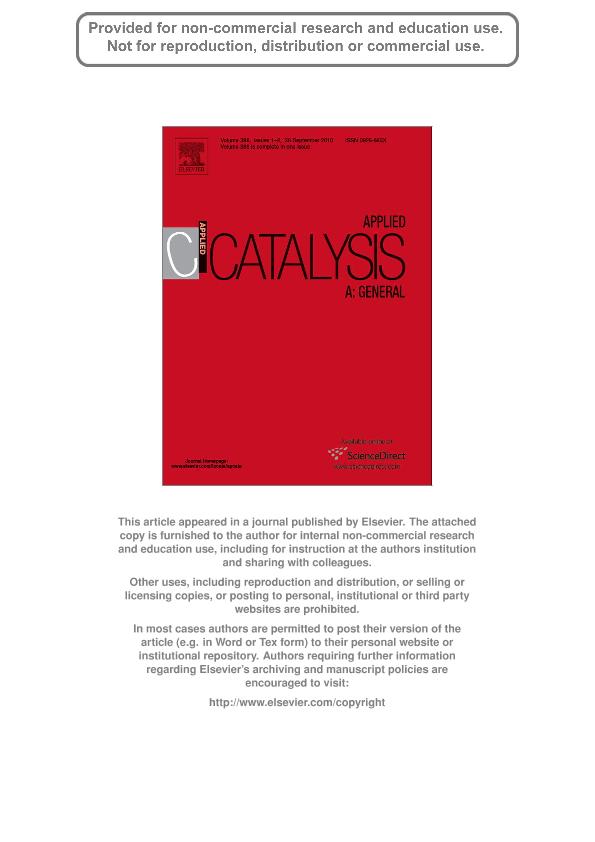Artículo
Ethylbenzene production over platinum catalysts supported on modified KY zeolites
Fonseca, Juliana Da Silva Lima; Júnior, Arnaldo Da Costa Faro; Grau, Javier Mario ; Rangel, Maria do Carmo
; Rangel, Maria do Carmo
 ; Rangel, Maria do Carmo
; Rangel, Maria do Carmo
Fecha de publicación:
09/2010
Editorial:
Elsevier Science
Revista:
Applied Catalysis A: General
ISSN:
0926-860X
Idioma:
Inglés
Tipo de recurso:
Artículo publicado
Clasificación temática:
Resumen
Platinum catalysts supported on zeolite KY (Si/Al = 12.7), modified with magnesium, calcium or barium, were evaluated in n-octane reforming to produce ethylbenzene. The catalysts were characterized by nitrogen adsorption, 27Al and 29Si solid state nuclear magnetic resonance, Fourier transform infrared spectroscopy using carbon monoxide or pyridine, metal dispersion measurements and programmed temperature oxidation. No significant structural change was noted for the solids due to the dopants except<br />for barium, which decreased the specific surface area, due to the partial blockage of the zeolite channels by the large size ions. However, a decrease was noted for all samples due to platinum, which partially blocked the zeolite channels. Barium also decreased the crystallinity while platinum caused this effect only for calcium and barium-containing samples, due to the structure partial collapse. Metallic platinum species in several electronic states were detected in the cages of zeolite, barium-containing catalyst showing the most electron-enriched platinum atoms. The amount of Lewis and Brønsted acid sites increased due to magnesium and calcium but barium increased only the amount of Lewis acid sites, as compared to potassium-containing solid. The catalysts with magnesium and barium showed the same platinum dispersion, which was higher than the one containing calcium. All catalysts were active in n-octane reforming at 723K and selective to ethylbenzene, but the conversion dropped with time reaction due to the decrease of specific surface area and to coke deposition. The calcium-containing sample produced the hardest coke, which led to the highest drop in conversion. The n-octane conversion was supposed to occur by a monofunctional mechanism but the bifunctional mechanism also seemed to occur due to the residual acidity of the catalysts. The calcium and barium-containing catalysts were the most selective to<br />ethylbenzene, due to electron-enriched platinum species related to promoters, but the low ethylbenzene selectivity for the magnesium-containing catalyst was compensated by its high conversion, resulting in similar yields for all catalysts.
Palabras clave:
N-Octane Reforming
,
Y Zeolite
,
Ethylbenzene
,
Coke
,
Barium
,
Calcium
,
Magnesium
Archivos asociados
Licencia
Identificadores
Colecciones
Articulos(INCAPE)
Articulos de INST.DE INVEST.EN CATALISIS Y PETROQUIMICA "ING. JOSE MIGUEL PARERA"
Articulos de INST.DE INVEST.EN CATALISIS Y PETROQUIMICA "ING. JOSE MIGUEL PARERA"
Citación
Fonseca, Juliana Da Silva Lima; Júnior, Arnaldo Da Costa Faro; Grau, Javier Mario; Rangel, Maria do Carmo; Ethylbenzene production over platinum catalysts supported on modified KY zeolites; Elsevier Science; Applied Catalysis A: General; 386; 9-2010; 201-210
Compartir
Altmétricas



